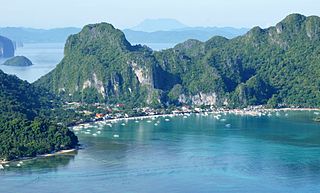Related Research Articles

Palawan, officially the Province of Palawan, is an archipelagic province of the Philippines that is located in the region of Mimaropa. It is the largest province in the country in terms of total area of 14,649.73 km2 (5,656.29 sq mi). The capital city is Puerto Princesa. Palawan is known as the Philippines' Last Frontier and as the Philippines' Best Island.

Mimaropa, formally known as the Southwestern Tagalog Region, is an administrative region in the Philippines. It was also formerly but still colloquially designated as Region IV-B until 2016. It is one of two regions in the country having no land border with another region. The name is an acronym combination of its constituent provinces: Mindoro, Marinduque, Romblon and Palawan.

Southern Tagalog, designated as Region IV, was an administrative region in the Philippines that comprised the current regions of Calabarzon and Mimaropa, the province of Aurora of Central Luzon, and several cities of Metro Manila. The name remains as a geographical region only, which exempts Aurora.

El Nido, officially the Municipality of El Nido, is a 1st class municipality in the province of Palawan, Philippines. According to the 2020 census, it has a population of 50,494 people.

Tagbanwa is one of the scripts indigenous to the Philippines, used by the Tagbanwa and the Palawan people as their ethnic writing system.

Puerto Princesa, officially the City of Puerto Princesa, is a 1st class highly urbanized city in the Mimaropa region of the Philippines. According to the 2020 census, it has a population of 307,079 people.

Quezon, officially the Municipality of Quezon, is a 1st class municipality in the province of Palawan, Philippines. According to the 2020 census, it has a population of 65,283 people.

Palawan, the largest province in the Philippines, is home to several indigenous ethnolinguistic groups namely, the Kagayanen, Tagbanwa, Palawano, Taaw't Bato, Molbog, and Batak tribes. They live in remote villages in the mountains and coastal areas.

The kubing is a type of Philippine jaw harp from bamboo found among the Maguindanaon and other Muslim and non-Muslim tribes in the Philippines and Indonesia. It is also called kobing (Maranao), kolibau (Tingguian), aru-ding (Tagbanwa), kuribaw, aribao (Isneg), aroding (Palawan), kulaing (Yakan), ulibaw (Kalinga), karombi (Toraja), yori (Kailinese) or Kulibaw. Ones made of sugar palm-leaf are called karinta (Munanese), ore-ore mbondu or ore Ngkale (Butonese).

The Tagbanwa people are one of the oldest ethnic groups in the Philippines, and can be mainly found in the central and northern Palawan. Research has shown that the Tagbanwa are possible descendants of the Tabon Man, thus making them one of the original inhabitants of the Philippines. They are a brown-skinned, slim, and straight-haired ethnic group.
The Palawano languages are spoken in the province of Palawan in the Philippines, by the Palawano people.
The Agutaynen language is spoken on Agutaya Island in the province of Palawan in the Philippines.
The legislative districts of Palawan are the representations of the province of Palawan and the highly urbanized city of Puerto Princesa in the various national legislatures of the Philippines. The province and the city are currently represented in the lower house of the Congress of the Philippines through their first, second, and third congressional districts.
The Tagbanwa are an ethnic group of Palawan, Philippines.
The Kalamian languages are a small cluster of languages spoken in the Philippines: Calamian Tagbanwa and Agutaynen. Other languages called Tagbanwa, the Aborlan Tagbanwa language and Central Tagbanwa language are members of the Palawanic languages.
The Palawanic languages are a subgroup in the Greater Central Philippine-family spoken on the island of Palawan and nearby islets.
Calamian Tagbanwa is spoken in the Calamian Islands just north of Palawan Island, Philippines. It is not mutually intelligible with the other languages of the Tagbanwa people. Ethnologue reports that it is spoken in Busuanga, Coron, Culion, and Linapacan municipalities.
Central Tagbanwa is spoken on Palawan Island in the Philippines. It is not mutually intelligible with the other languages of the Tagbanwa people.
Batak is an Austronesian language spoken by the Batak people on Palawan Island in the Philippines. It is sometimes disambiguated from the Batak languages as Palawan Batak.

Palawan's 3rd congressional district is one of the three congressional districts of the Philippines in the province of Palawan. It has been represented in the House of Representatives since 2013. The district is composed of the city of Puerto Princesa and adjacent municipality of Aborlan. It was created after the 2012 reapportionment that redrew the boundaries of the 2nd district and allocated a new district for Palawan's capital and only city. It is currently represented in the 19th Congress by Edward Hagedorn of PDP-Laban.
References
- 1 2 Aborlan Tagbanwa at Ethnologue (25th ed., 2022)

- 1 2 Reid, Lawrence A. (1971). Philippine Minor Languages: Word Lists and Phonologies. University of Hawai'i Press. p. 41.
- ↑ Quakenbush, J. Stephen; Ruch, Edward (2006). Pronoun Ordering and Marking in Kalamianic (PDF). Paper presented at the Tenth International Conference on Austronesian Linguistics, 17–20 January 2006, Puerto Princesa City, Palawan, Philippine. Retrieved 23 May 2020.